What Kind of Exercise is Right for You?

Shannon Speed
Start the new semester with the right foot! Shannon Speed explains different types of exercises that you can work on, as well as other recreational activities to keep you healthy and active. Shannon is one of the Miami Recreational Center’s Assistant Directors of Fitness, she is also a Certified Personal Trainer and Group Fitness instructor.
Cardiovascular Exercise vs. Weight Training
There are a variety of ways to participate in activities that challenge cardiovascular health. Things such as golfing, yard-work, and bowling are all technically forms of cardiovascular exercise. It is recommended to participate in cardiovascular activity 3-5 times per week at a moderate to vigorous intensity, for about 30 minutes. In total, you should be getting 150 minutes of cardiovascular exercise per week, but how you break it up is really up to the individual. For some people golfing may be vigorous enough to serve as an appropriate form of exercise. However, it’s more likely that college students will need to engage in activities like running, biking, basketball, or climbing stairs.
Weight training is also an important component of exercise. It is recommended to weight train 2-3 times per week, making sure to take rests between weight training days. The Recreation Center has a multitude of weight training machines, in addition to free weights. If you are just beginning with a weight training regimen, it can be daunting and the first few days may be a struggle, but it’s well worth it.
E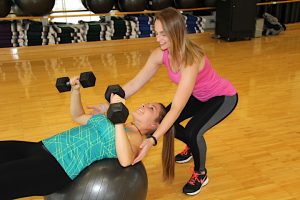 ach have their own benefits. Cardiovascular exercise can reduce the risk of coronary heart disease, improves cardiovascular and respiratory function, and decreases anxiety. Weight training is known to improve bone density, decrease the risk for injury, and increase fat-free mass. Many people will choose to participate in either cardiovascular exercise or weight training, but the reality is that they are both most effective when combined. Both improve overall quality of life and contribute to enhanced feelings of well-being and self-confidence.
ach have their own benefits. Cardiovascular exercise can reduce the risk of coronary heart disease, improves cardiovascular and respiratory function, and decreases anxiety. Weight training is known to improve bone density, decrease the risk for injury, and increase fat-free mass. Many people will choose to participate in either cardiovascular exercise or weight training, but the reality is that they are both most effective when combined. Both improve overall quality of life and contribute to enhanced feelings of well-being and self-confidence.
Group Fitness vs. Personal Training
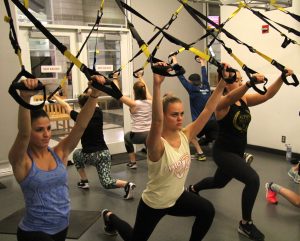
This is a long standing battle for some as Group Fitness and Personal Training are complete opposites. Group Fitness in is a group setting of anywhere from 2 to 50 people and offers a variety of modes of exercise. For example, at the Recreation Center our offerings include: Pilates, Vinyasa Yoga, Ashtanga Yoga, Yoga Pilates, Barre, Spinning, Toning, Bootcamp, Tabata, Zumba®, Indo-Row®, Shockwave®, TRX®, SilverSneakers®, Kettlebell, Baby & Me Yoga, Kickboxing, Abs classes, Cardio classes, and a variety of classes with different combinations of those options. The downside is that Group Fitness isn’t as personalized. There are many instructors that cater toward regular participants, but there are no fitness assessments performed to monitor progress, and sometimes your favorite class is only available once a week.
Personal Training is personalized. A health assessment and profile is typically completed beforehand to gauge where to begin in the fitness program. You also have the capability of meeting with the trainer more than once per week. The downside is that you may not have the support of a group, and personal training may not be as entertaining for those that like the music and interaction with others. In some cases there is a happy medium, and we do offer this option at the Rec Center.
Small Group Training isn’t a new form of fitness, but it’s not something that many people know about. In this setting of 2-5 people you have the best of both worlds: a social network, and individualized attention. If you’re considering beginning a Group Fitness or Personal Training program, you should make sure you’re aware of all of your options so you can choose what’s best for you.
Informal vs Formal Recreation
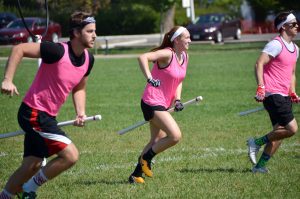
Club Quidditch
Most people don’t understand the difference between these two forms of recreation because “formal” is often associated with staunch or uptight. However, the real difference is really whether or not you are participating in something organized or unorganized. Informal recreation is anything from going to the fitness center to run on the treadmill, to playing a pick up basketball game, or climbing at the rock wall during open climbing hours.
Formal recreation, on the other hand, includes activities like participating in an intramural soccer game, training with a personal trainer, or going on an organized adventure trip. More often, formal recreation is performed with friends or a social network whereas informal recreation may be on your own. That said, both are forms of recreation and, as long as you are getting exercise, are great options.
Most of the time your choice between informal and formal recreation is based on a personal preference. Do you prefer to exercise on your own or do you prefer to exercise with others? Or maybe you’d rather do both? There’s nothing that says you can’t participate in both an intramural soccer game, and run on the treadmill in the fitness center on your own.
By Shannon Speed
Posture: Yoga and Pilates
Part II

Holly Wilson, Rec Yoga, and Pilates Instructor
Holly Wilson is one of our Yoga and Pilates instructors and has been teaching the Miami and Oxford Community for over 15 years. As a physical-mind instructor she gives us her perspective and insight on posture as she associates it with her two disciplines.
Wilson says that you’re going to learn the most about your muscular imbalances, postural habits and the best ways to correct it through Yoga and Pilates. She states that “Yoga and Pilates are about posture because they encompass the strength of the muscles that support the torso and the spine”. Her goal as an instructor is to give people the awareness and techniques to change the way they hold and move themselves in class.
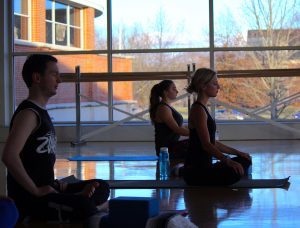
Major problems of bad postural habits
Wilson emphasized that head-forward, also known as tech-neck is a big problem. She explained that head-forward or tech-neck causes around 60 pounds of displaced weight to rest in the front of the body. This causes slumping through the shoulders which affects your overall balance. Additionally, this can load hip flexors and often causes you to hinge forward, which results in over-contracting your back and possibly compressing your organs. Another big problem she sees is individuals pushing ribs out and forward which is known as rib thrust, which can cause organ displacement.
Conclusion
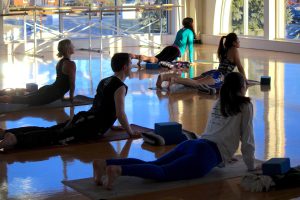
Good posture involves much more than appearance. It encompasses health benefits and prevents short
and long-term
consequences including bone development and density, as well as back pain which is the most common one. Holly Wilson says that if you manage to make good posture a habit, it will lock in at the cellular level and thus becoming a part of you. Both professionals accentuated that ultimately you control your postural habits and that you must strive to maintain them.
By Dania Puente
A Personal Trainer’s Perspective, Insight and Advice on Posture
Do you ever look at yourself in the mirror and within seconds you straighten your back? There is much more to good posture than its aesthetic aspect. Poor posture can have consequences that go beyond back pain. Therefore the Rec marketing team decided to interview two of our beloved Rec staff Holly Wilson and John Hofmann. In this two-part series, we will highlight the importance of posture and what services the Rec offers to help with this from two perspectives.
Part I
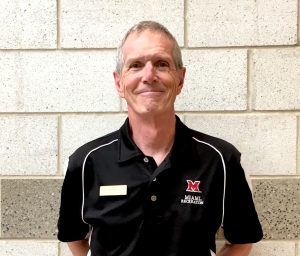
John Hofmann, Rec Center Personal Trainer
John Hofmann has been a personal trainer here at the Rec for over nine years. He’s not only a personal trainer but an endurance sports lover having participated in running, cycling and triathlon competitions. With his experience and knowledge, Hoffman will help us understand what good posture is and what he does as a personal trainer to help with this.
What is good posture?
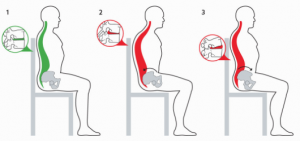
Hofmann explains that there’s a postural difference when sitting and standing. Posture when sitting:
have
space between your feet, lower legs and the chair, sit up straight and have your knees at a 90-degree angle. The curve of the spine must be supported without bending, as that puts our vertebrate into compression.
Posture when standing: stand wit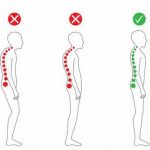 h feet aligned with the shoulders, putting a little more weight on the balls of your feet, arms relaxed and head up over the spine. Hofmann emphasizes that there are many reasons why you don’t have natural posture, for example, you can have a skeletal inconsistency or muscular imbalances.
h feet aligned with the shoulders, putting a little more weight on the balls of your feet, arms relaxed and head up over the spine. Hofmann emphasizes that there are many reasons why you don’t have natural posture, for example, you can have a skeletal inconsistency or muscular imbalances.
What a Rec personal trainer can do to help you with posture?
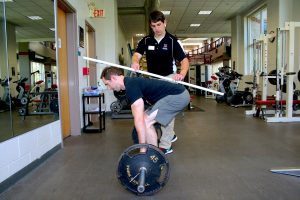
Although helping with posture is not a personal trainer’s principal goal, posture is indeed adjusted when training with a professional here at the Rec Center. The right posture is essential when lifting and our personal trainers will make sure you have the appropriate posture to keep you safe. What Hofmann does and has his clients do is when they walk into the Rec, they should think about posture. Also working on balance is essential, one of the reasons why there are mirrors in the fitness rooms is so you can see when you’re doing exercises, that you’re doing them symmetrically, you can also see how you’re moving. Being able to see how you look also reinforces standing tall and sitting straight.
Hofmann says that the primary problem of poor posture is back issues. Usually, when you have back issues it is in the lower back, where most of the body weight is supported on the spine. If you’re tilted consistently you can cause damage to the muscle and skeletal system.
STAY TUNED! Next Holly Wilson gives us her postural advice from a physical-mind discipline instructor perspective.
By Dania Puente
MOVE is on the move!
We are excited to announce that MOVE is on the move! Miami & Oxford Value Exercise Bootcamps, also known as MOVE Bootcamp is a collaborative initiative between Miami Rec Sports Fitness Department and the President’s Office. We began MOVE Bootcamp back in Spring of 2017. Once a month small groups of community members and students would meet to sweat it out in President and Dr. Crawford’s backyard. The initiative, which originally started out as a campaign to improve Miami and the Oxford community’s overall health, has turned into a way to bring students and members of the community together. MOVE Bootcamps are all-encompassing and open to all ages, respectively including ages 8 to 70 participate in previous MOVE Bootcamps.

M.O.V.E Outdoor Bootcamp with the Crawfords at Lewis Place.
This year, Miami Rec Sports Fitness Department and the President’s Office decided to collaborate with other on and off campus partners. On November 11, 2017, we will hold our largest MOVE Bootcamp yet! We have collaborated with Miami University Air Force and Army ROTC’s who will create the workout program! Athletics has also been an active participant, donating space in the Dauch Indoor Sports Center, and providing additional marketing.

The most exciting part of this MOVE Bootcamp is the added fundraising component. MOVE Bootcamp is showing support for Toys for Tots, a Marine organized program.
No registration is required for MOVE Bootcamp, just show up with a smile and willingness to work hard! Spring 2018 MOVE Bootcamp dates have yet to be determined.
Bring a toy or two and join us at 10:30 am on Saturday, November 11, 2017, at the Dauch Indoor Sports Center located at 800 Weeb Ewbank Way, Oxford, OH 45056.
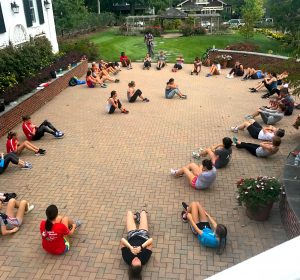
If you have questions or are interested in collaborating on future MOVE Bootcamps please contact Assistant Director of Fitness, Shannon Speed, at speeds@MiamiOH.edu or (513) 529-2193.
By Shannon Speed


